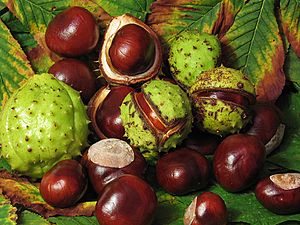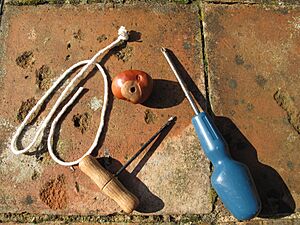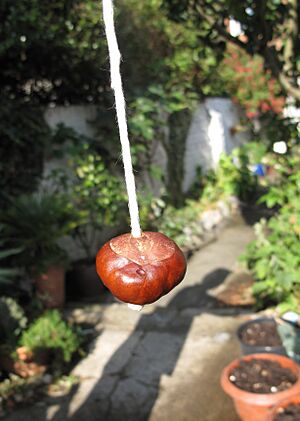Conkers facts for kids

Conkers is a fun, traditional game played by children in Great Britain and Ireland. It uses the shiny, brown seeds from horse chestnut trees, which are also called 'conkers'. The game involves two players, each with a conker threaded onto a piece of string. Players take turns hitting each other's conker until one of them breaks.
Contents
How Conkers Began
The game of Conkers has been around for a long time! The first time we hear about a game like this was in 1821, but back then, people used snail shells or hazelnuts instead of horse chestnuts. Using horse chestnuts became popular around the 1850s, and the game quickly spread across England and beyond.
The very first game of Conkers using horse chestnuts was recorded on the Isle of Wight in 1848.
No one is completely sure where the name "conker" came from. It might come from an old word meaning "knock out," or it could be related to the French word for a conch shell, since shells were used in earlier versions of the game. Some people think it's linked to the word "conquer," because players try to conquer their opponent's conker. Another idea is that the name sounds like the "conk!" noise the seeds make when they hit each other. Sometimes, conkers are called cheesers if they have flat sides, or cobblers in some areas.
Playing the Game
To play Conkers, you first need to prepare your conker:
- Find a large, hard conker.
- Carefully drill a hole through it using a nail or a small tool.
- Thread a piece of string, about 20 centimeters (8 inches) long, through the hole. A shoelace works well!
- Tie a big knot at one or both ends of the string to keep the conker from slipping off.
The game is played by two people, each with their prepared conker.
- Players take turns hitting each other's conker.
- One player holds their conker still, letting it dangle on the full length of the string.
- The other player swings their conker and tries to hit the opponent's conker.
Scoring Points
- When one conker breaks, the other conker (the one that survived) gets a point. This happens whether the surviving conker was the one hitting or the one being hit.
- A brand new conker is called a none-er because it hasn't won any games yet.
- As a conker wins, its name changes: a none-er becomes a one-er, then a two-er, and so on, depending on how many conkers it has defeated.
- In some places, the winning conker gets all the points the losing conker had, plus one more point for the win! For example, if a "two-er" beats a "three-er," it might become a "six-er" (2 + 3 + 1 = 6). In other places, the winner just gets one point, no matter how many points the loser had.
Special Rules
- If the strings of both conkers get tangled, the first player to shout "strings" or "stringsies" gets an extra turn.
- If a player drops their conker, the other player can shout "stamps" or "stampsies." This means they can try to break the dropped conker by stamping on it. But if the player who dropped their conker shouts "no stamps" first, then no stamping is allowed!
Making Conkers Stronger
The strongest conkers usually win! Some people try to make their conkers harder by keeping them for a year (these are sometimes called laggies), baking them, soaking them in vinegar, or even painting them with clear nail varnish. However, doing this is usually seen as cheating!
At official championships, like the British Junior Conkers Championships, players are often not allowed to bring their own conkers. This is to make sure no one has cheated by hardening them.
Conker Championships
Since 1965, the World Conker Championships have been held every year in Ashton, England. Thousands of people come to watch competitors from all over the world!
In 1976, a player from Mexico, Jorge Ramirez Carrillo, became the first non-British person to win the Men's World Conker Championship. In 1998, Helmut Kern from Germany also won.
The Irish Conker Championships started in 1999. In 2001, Eamonn Dooley from Ireland set a world record by smashing 306 conkers in just one hour!
There's also a North American Conker Championship, which began in 2012 in Nova Scotia, Canada. Many players have competed there, showing that the game is loved around the world!
Safety in Conkers
In the past, some schools stopped children from playing conkers because they worried about injuries or that conkers might be used as weapons. However, experts say that playing conkers is generally safe.
There were also some concerns about nut allergies, but health experts have said that handling conkers does not usually cause problems for people with nut allergies, though a mild rash might occur for some.



